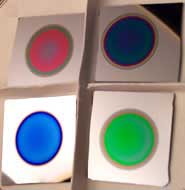Bacteria make bandage glow

Warning colours: bacteria make silicon wafers glow. <br>© University of Rochester
A microelectronic sensor may alert doctors to bacterial hazards.
Smart bandages could soon alert doctors to the presence of certain bacteria in a wound by glowing different colours. Researchers in the United States have created a tiny device that emits faint light of two colours in response to two types of bug1.
Benjamin Miller, of the University of Rochester in New York State, and colleagues hope that a refined sensor might ultimately generate an instant and easily recognizable array of colours that signify dangerous or antibiotic-resistant strains. So far, the device produces only a very small colour change, which is not detectable with the naked eye.
Currently, the faint glow alters only in the presence of ’Gram-negative’ bacteria. Most bacteria are either ’Gram-positive’ or Gram-negative; a dye called crystal violet stains Gram-positive bacteria blue-violet and Gram-negative bacteria red. This staining procedure was discovered in 1884 by the Danish biologist Hans Christian Joachim Gram and is still used today to distinguish the two cell types.
Differences in the chemical composition of the bacteria’s cell walls cause the dye to be taken up differently. A consequence of these differences is that Gram-positive bacteria are more susceptible to antibiotics, so the test can still be useful for treating infections.
Miller’s team hope to replace the cumbersome staining procedure with a simple process that registers the difference instantly and in situ. To develop the sensor, the team collaborated with Philippe Fauchet, also at Rochester, a specialist in silicon-based light-emitting devices.
Researchers like Fauchet are primarily interested in making silicon glow, to render light-based fibre-optic telecommunication compatible with silicon-chip micorelectronics. Silicon is usually a very poor light emitter, but it can be persuaded by etching it with acid to give it a porous, sponge-like structure.
Fauchet and the team found that, when Gram-negative bacteria stick to the surface of porous silicon, the colour of the light emitted changes slightly. The researchers make the silicon attract Gram-negative, but not Gram-positive, bacteria by coating it with specially designed molecules that hook chemical groups only present on Gram-negative microbes.
The team is now searching for molecular hooks that are specific to individual families of hazardous bacteria, such as Salmonella and Listeria.
References
- Chan, S., Horner, S. R., Fauchet, P. M. & Miller, B. L. Identification of Gram negative bacteria using nanoscale silicon microcavities. Journal of the American Chemical Society in the press (2001).
Media Contact
More Information:
http://www.nature.com/nsu/011108/011108-7.htmlAll latest news from the category: Health and Medicine
This subject area encompasses research and studies in the field of human medicine.
Among the wide-ranging list of topics covered here are anesthesiology, anatomy, surgery, human genetics, hygiene and environmental medicine, internal medicine, neurology, pharmacology, physiology, urology and dental medicine.
Newest articles

Innovative 3D printed scaffolds offer new hope for bone healing
Researchers at the Institute for Bioengineering of Catalonia have developed novel 3D printed PLA-CaP scaffolds that promote blood vessel formation, ensuring better healing and regeneration of bone tissue. Bone is…

The surprising role of gut infection in Alzheimer’s disease
ASU- and Banner Alzheimer’s Institute-led study implicates link between a common virus and the disease, which travels from the gut to the brain and may be a target for antiviral…

Molecular gardening: New enzymes discovered for protein modification pruning
How deubiquitinases USP53 and USP54 cleave long polyubiquitin chains and how the former is linked to liver disease in children. Deubiquitinases (DUBs) are enzymes used by cells to trim protein…



